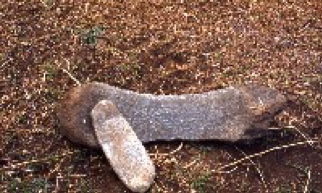Labour-saving technologies and practices: manual crop processing
The following technology provides information on the features of grain milling, oil extraction, rice hulling, cassava processing, and coffee processing. Advantages and disadvantages of the practices are also given, including labour saving, livelihood resilience strengthening, livelihood diversification, equipment, infrastructure, costs and risks.
This technology is also available in: Portuguese (ID1317)
Description
1. Features of grain milling
Grain milling is traditionally carried out by a series of techniques.
- Pounding with a pestle and mortar, made from a large pole and the hollowed out section of a tree trunk.
- This is also used for hulling in which case the product is often placed in a bag.
- There are very low outputs of about 0.5 kg per hour.
- Reciprocating grinding between two flat stones, such as volcanic basalt, granite or sandstone.
- There are low outputs of around 1 kg per hour.
- Rotational grinding using a Quern (two round flat stones).
- Grain is poured through a hole in the upper stone as it rotates over the lower stone.
- The milled grain comes out at the edges.
- There are low outputs of around 1 kg per hour.
- Output per person using a Quern can be increased substantially by using larger stones with a good axis and by using several people or draught animals to rotate the stones.
- Skill is required in shaping the stones and channelling their faces in order to grind the grain efficiently and obtain the right fineness of flour.
2. Features of oil extraction
- Few traditional methods of oil extraction exist except for palm oil which is based on boiling pans, large pounding sticks and lever presses.
- Screw or hydraulic presses can be used on several oil seeds (including palm oil, sheanuts, groundnuts, soya and sunflower) and on cassava dough.
- The press is made from a frame and pressing table with a large diameter piston in a pressing chamber made of perforated steel plate.
- The piston is either forced down with a manually operated screw or hydraulic press.
- These machines process around 5 kg per hour of cassava dough or 1 kg per hour of ground sheanuts.
- The Bielenberg Ram Press can be used on several oil seeds (including groundnuts, soya and sunflower).
- A ram is operated by a lever to force the seed into a steel conical cage, extruding the oil through the gaps in the cage.
- It is effective but has a very low work rate.
3. Features of rice hulling
- Small hand operated hullers use a ribbed horizontal cast iron rotor within a cast housing with a slotted plate in the base to allow the rice and hulls to fall through.
- Outputs are up to 14 kg per hour.
- A huller that can be operated by two people claim outputs of over ten times this figure.
4. Features of cassava processing
- Traditionally the tubers are hand peeled, washed, hand grated or pounded with pestle and mortar and then fermented in bags or jars.
- After two to three days the water is expelled by heavy stones or lever presses, and the tubers are dried and pre-cooked.
- Manually operated root cutters and cassava graters reduce the labour input.
5. Features of coffee processing
- Hand operated coffee pulpers are usually based on vertical disks with protrusions that force the coffee cherry against blades to strip the flesh off the coffee hull.
- These are then separated from the pulp.
- Adequate water is required to wash away the flesh.
- Outputs are up to 300 kg per hour.
- Coffee hullers are used where the beans are removed from their hulls using small hullers with a ribbed horizontal cast iron rotor within a cast housing, with wire mesh on the underside.
- Outputs are of around 20 kg to 36 kg per hour.
- The beans, hulls and dust are separated by sieves and winnowing.
6. Advantages
6.1 Labour-saving
- These practices provide higher work rates than traditional methods.
6.2 Livelihood resilience strengthening
- Crop processing improves the nutritious value of crops, which benefits both the product market value and the food security of the consumers.
6.3 Livelihood diversification
- The practice provides an opportunity for households to engage in small market sales of processed crops.
- Some may establish crop processing business and hire services to the community.
6.4 Equipment
- The equipment is robust and simple to operate.
6.5 Infrastructure
- The equipment relatively easy to fabricate, maintain and repair.
7. Disadvantages
7.1 Equipment
- Prior to processing the product should ideally be clean and free of moulds, fungal infections and pests.
7.2 Cost
- For manually operated equipment, the moderate increase in work rates for some items may not justify the cost of the equipment.
7.3 Cost and risk
- The equipment has a relatively high cost for private ownership and hence is a relatively high financial risk.
- The use of these practices may fail if hiring services are introduced into an area where there is insufficient demand to pay for contractual or community-owned services.
Figure 1. Grinding

©FAO/TECA
8. Related/associated technologies
- Labour-saving technologies and practices: seeds and crops: ID 7302.
- Labour-saving technologies and practices: solar drying equipment: ID 7319.
- Labour-saving technologies and practices: row planting, hand seeders and planters: ID 7301.
This technology is also available in Portuguese: ID 1317.
9. Objectives fulfilled by the project
9.1 Labour-saving technology (LST)
The work rates are higher using these practices.
9.2 Resource use efficiency
The nutritious value of the crops is improved.
9.3 Pro-poor technology
Through improved crops, food security and product market value are improved, leading to an increase in sales and the establishment of business.
